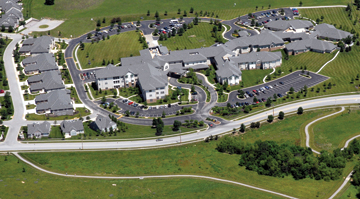 What a difference five years have made for Village Shalom.
What a difference five years have made for Village Shalom.
It was just a handful of years ago that Village Shalom was struggling under a capital debt of about $39 million. But thanks to a multifaceted strategy, a broad-based commitment to action and a measure of serendipity, the continuing-care retirement community recently refinanced its existing debt of $12.1 million at a remarkably low 3.27 percent interest rate. The transaction closed in late May 2013.
“Our debt level is now at a size that we can afford,” said Matthew Lewis, president and CEO. “We are now living within our means.”
The $39 million remained from the original $47 million debt on Village Shalom’s 26-acre Overland Park campus, which opened in 2000. Efforts since that time to reduce the outstanding balance to a manageable level had not progressed as hoped. Interest expense, rising health care costs and reductions in Medicare/Medicaid funding led to annual losses that eroded the organization’s reserves.
In 2008, a special committee of the Village Shalom board of directors initiated an intricate, four-pronged strategy to reduce the organization’s debt. This strategy involved interdependent participation by the organization’s major creditor (a global bank), Kansas City’s Jewish funding organizations (the Jewish Heritage and Menorah Legacy foundations) and individual donors, along with a plan to retire bonds purchased by private investors in 1998 to help fund the new Village Shalom campus.
By late 2011, a large portion of that debt-reduction campaign effort had come to fruition. The bank agreed to write down its portion of the debt by approximately $6 million — a discount of 31 percent. This transaction enabled the release of $1.5 million in debt-service reserve funds to further pay down debt. The Jewish Heritage and Menorah Legacy foundations collectively committed $8 million in matching funds, dependent upon a similar amount raised from private donors. Ultimately, private contributions topped $10 million, due in large part to an extraordinary effort led by longtime Village Shalom supporter Stan Bushman.
Concurrent with these events, Village Shalom continued to make principal payments amounting to $1.4 million, thereby reducing the debt even further.
With privately held bonds still outstanding, however, work remained to be done. This last portion of debt — the “fourth prong” of the debt-reduction strategy — “was always the most perplexing and challenging of the four areas to address,” explained James Klein, a member and past chairman of the Village Shalom board and a leader of the debt-reduction committee.
“We had a disparate group of investors who owned bonds that we couldn’t identify because of the nature of bond issuance. We did our best to buy back as many of those bonds as we could,” he commented.
 However, as interest rates continued their downward trend in 2012-13, so did bondholders’ willingness to sell. “It was a two-edged sword,” Klein said. “While bonds were more difficult to buy back, banks were sitting on a lot of cash earning nothing. Fortunately for us, they had an appetite to put it to work.”
However, as interest rates continued their downward trend in 2012-13, so did bondholders’ willingness to sell. “It was a two-edged sword,” Klein said. “While bonds were more difficult to buy back, banks were sitting on a lot of cash earning nothing. Fortunately for us, they had an appetite to put it to work.”
In this advantageous economic environment, Village Shalom made the decision to call the remaining bonds and refinance the debt, which had previously carried a 5.75 percent interest rate. Calling the bonds enabled the release of $1.7 million in bond-reserve funds, resulting in additional operating liquidity for Village Shalom. The refinanced loan — reduced through the above-mentioned chain of events to $12.1 million — took the form of a private-placement bond issue with four participating banks. The new loan is amortized at 3.27 percent fixed-rate interest over 15 years.
“We never could have imagined that the decline in interest rates would give us the opportunity to refinance our remaining debt directly at an interest rate normally reserved for the highest-credit issuers — not a non-rated, senior-living health-care organization,” remarked Klein.
“This [interest rate] essentially saves us $500,000 per year, and $7-8 million over the entire 15-year term,” said Lewis. “This was the best thing we could have done. It had the greatest favorable impact of any possible option, and it positions us well for the future.
“Now,” he added, “we can focus on the strategic position of the organization. We’re looking at different residential-living options, and home- and community-based services and programs” that would not have been feasible prior to the debt-reduction campaign and refinance.
“We want to expend more effort in diversifying our revenue streams so we’re not so susceptible to cuts in Medicare/Medicaid or dips in occupancy rates,” Lewis said, hastening to add that “none of this can work without the continued support of the Jewish funding organizations or our fundraising efforts within the community. Those are necessary ingredients in our success.”
The entire process has been significant not only for Village Shalom, but for the community that has supported it throughout its 100-year history.
“Because of the enormity of the need, there was a spirit of shared sacrifice,” noted Klein. “No one could or even should have been responsible to take on the entire burden, but the idea that support would come from multiple sources gave each the reinforcement that others cared deeply and felt a responsibility to save Village Shalom. This last step in the restructuring process should give the local funders — the Jewish Heritage and Menorah Legacy foundations — and the small group of significant donors great satisfaction that their contributions have now been leveraged by the successful refinancing of our remaining debt.”



